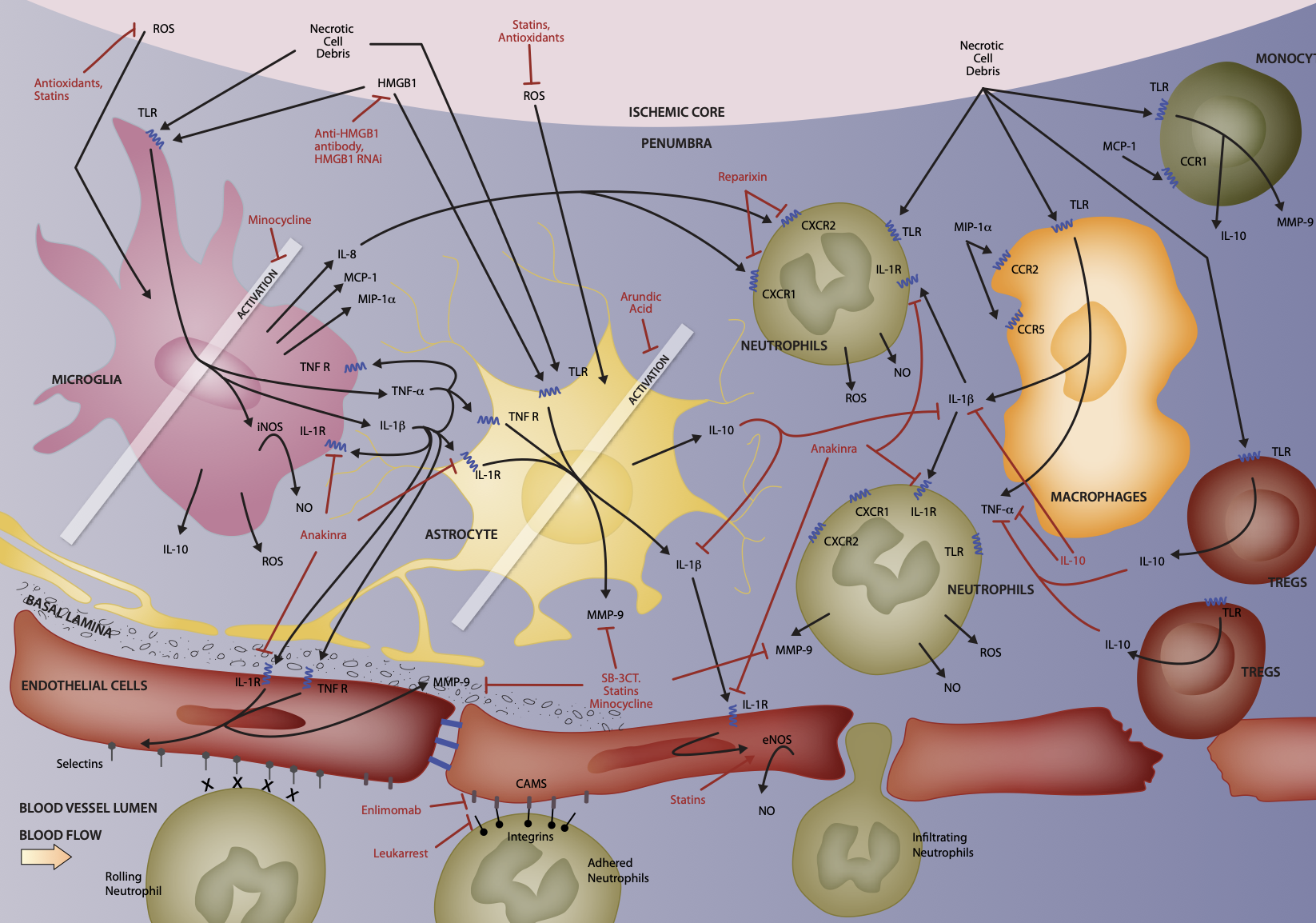Post-stroke neuroinflammation is a very complex phenomenon involving multiple resident and invading cell types at varying degrees of differentiation or activation - each expressing specific subsets of diffusable factors, receptors, cellular adhesion molecules and other markers - all of which is changing as time passes to create an initially neurotoxic and then finally neuroprotective environment. This inflammatory process in the penumbra offers a broad array of potential cellular and molecular targets with much wider therapeutic windows.
At the cellular level, neurons, microglia, astrocytes and cerebrovascular endothelial cells are the first affected by the ischemic conditions and their responses to massive cell death in neighboring tissue initiates the precisely timed arrival of successive subsets of leukocytes - first neutrophils, followed by monocytes, macrophages and finally T cels. Targeting these cells via manipulation of their phenotypes, activation states, movements into lesion sites ro their release of harmful mediators represents a major investigative pathway toward potential therapeutics for ischemic stroke sufferers.
We will break down the involvement of the various cells in this post-stroke neuroinflammatory environment, starting with microglia and astrocytes.
Microglia
Microglia are the first to detect and respond to ischemic conditions, showing signs of activation as early as a few minutes after infarct. Microglia are the resident brain immunocompetent cells and constitutively express a wide variety of pattern recognition receptors. After stroke, resting microglia detect the spilled cytoplasmic contents of necrotic cells as well as high levels of reactive oxygen species (ROS) and consequently transform to an active, phagocytic phenotype, functioning to clear dead cells, cellular debris and release pro-inflammatory and cytotoxic diffusible factors. Inhibitors of microglial activation, such as the multi-functional drug Minocycline, have been shown to reduce infarct size in preclinical stroke models when administered intraveneously in combination with rt-PA within 6 hours of infarct. At later timepoints, it appears microglia have neuroprotective effects, such as producing neurotrophic and other growth factors supporting neurogenesis and neural plasticity.
Astrocytes
Astrocytes normally provide energy, neurotrophic and neurogenic factors, neurotransmitter precursors and anti-oxidant defense to neurons. Like microglia, astrocytes also proliferate and differentiate in response to stroke and begin to produce pro-inflammatory and cytotoxic mediators as well as contribute to the loss of the blood-brain barrier (BBB) integrity. Astroglial activity begins at the core approximately 4 hours after stroke and may be observed for up to 28 days. Modulators of astrocyte function such as Arundic Acid appear to improve outcomes in preclinical stroke models. Like microglia, astrocyte activity appears to be initially damaging and later protective.
The complex interplay between resident and invading cells and their bioactive effector signalling molecules as they initially damage and later protect and repair brain tissue offers many opportunities for pharmacological intervention in clinical feasible therapeutic windows.
MD Biosciences offers preclinical stroke models for ischemic stroke research. Contact us to discuss a custom preclinical study design.
- Candelerio-Jalil, E. (2009) Current Opinion in Investigational Drugs 10(7):644
- Ceulemans, A.G., Zgvac, T., Kooijman, R., Hachimi-Idrissi, S., Sarre, S., Michotte, Y (2010) Journal of Neuroinflammation 7:74
- Downes, CE. and Crank, P.J. (2010) British Journal of Pharmacology 160:1872
- Lakhan, S.E., Kirchgessner, A., and Hofer, M. (2009) The Open Neurology Journal 4:34



